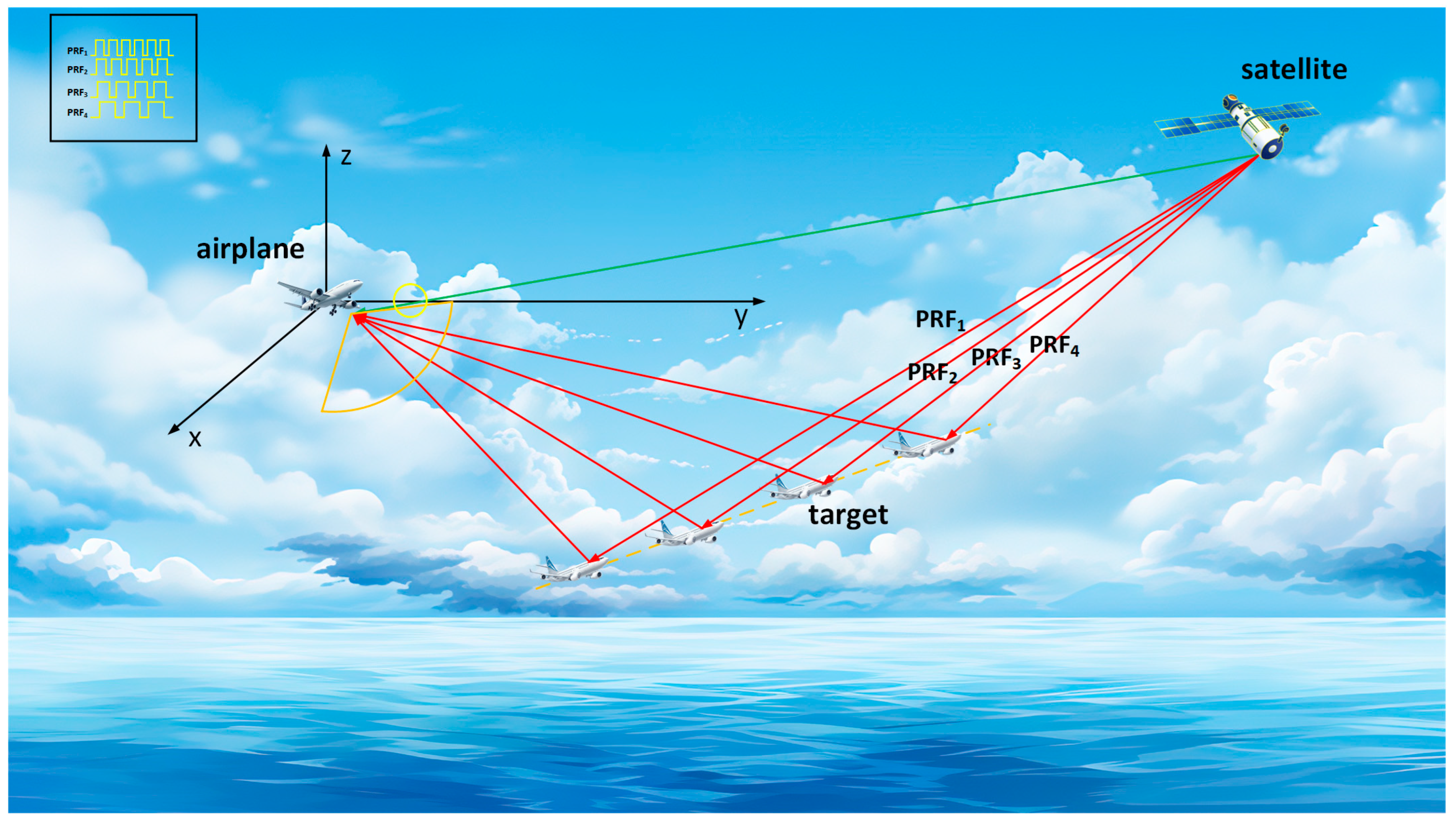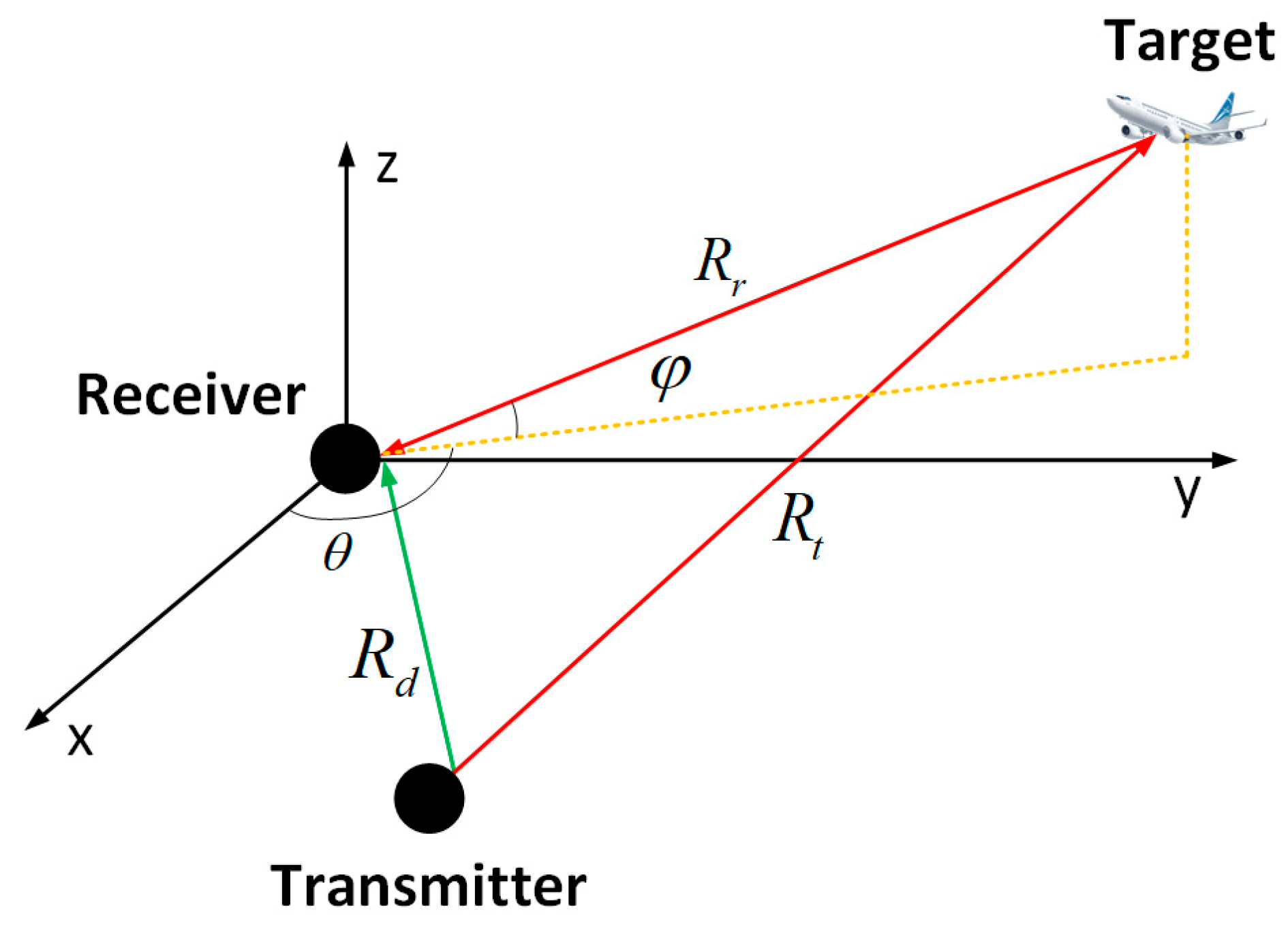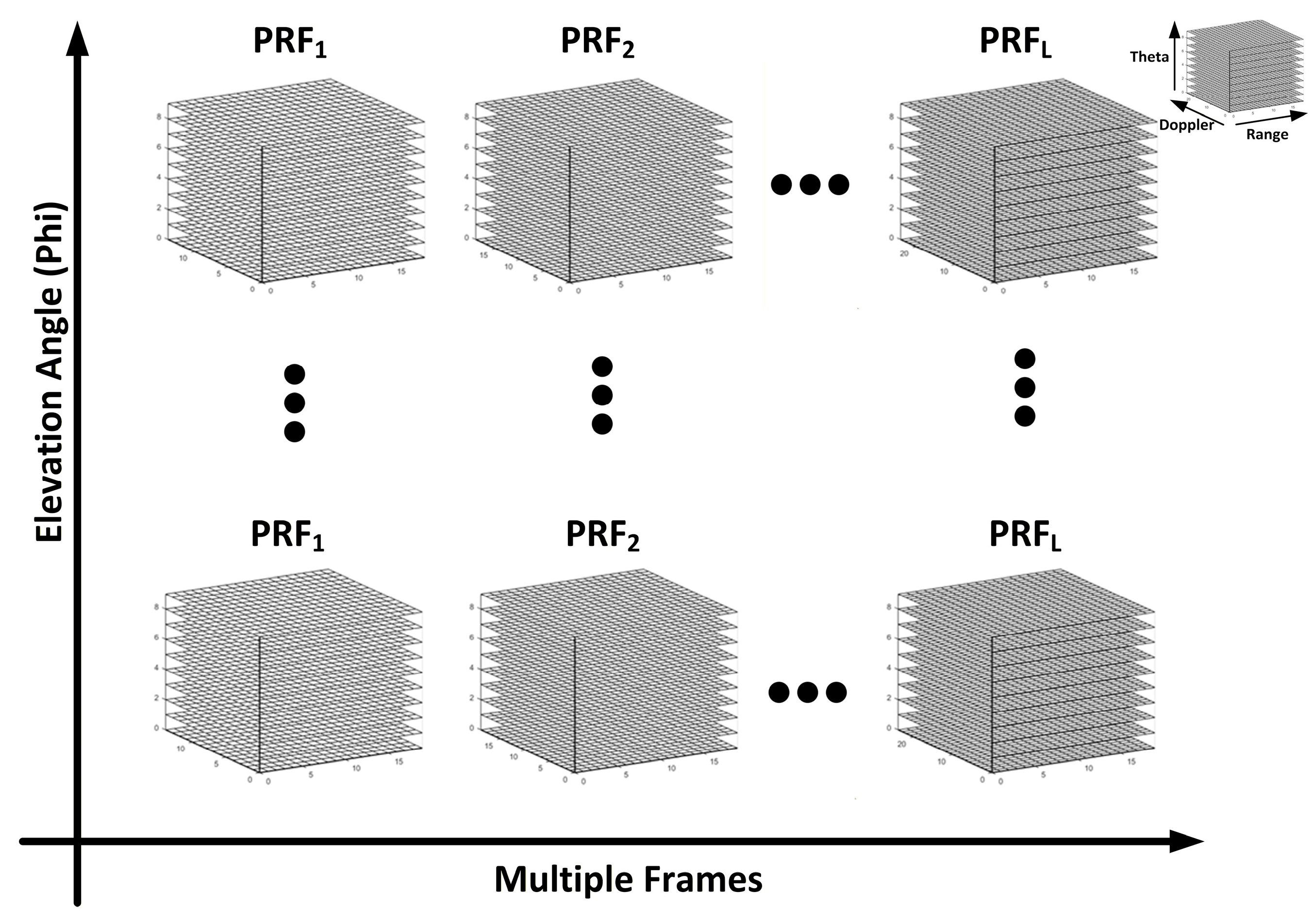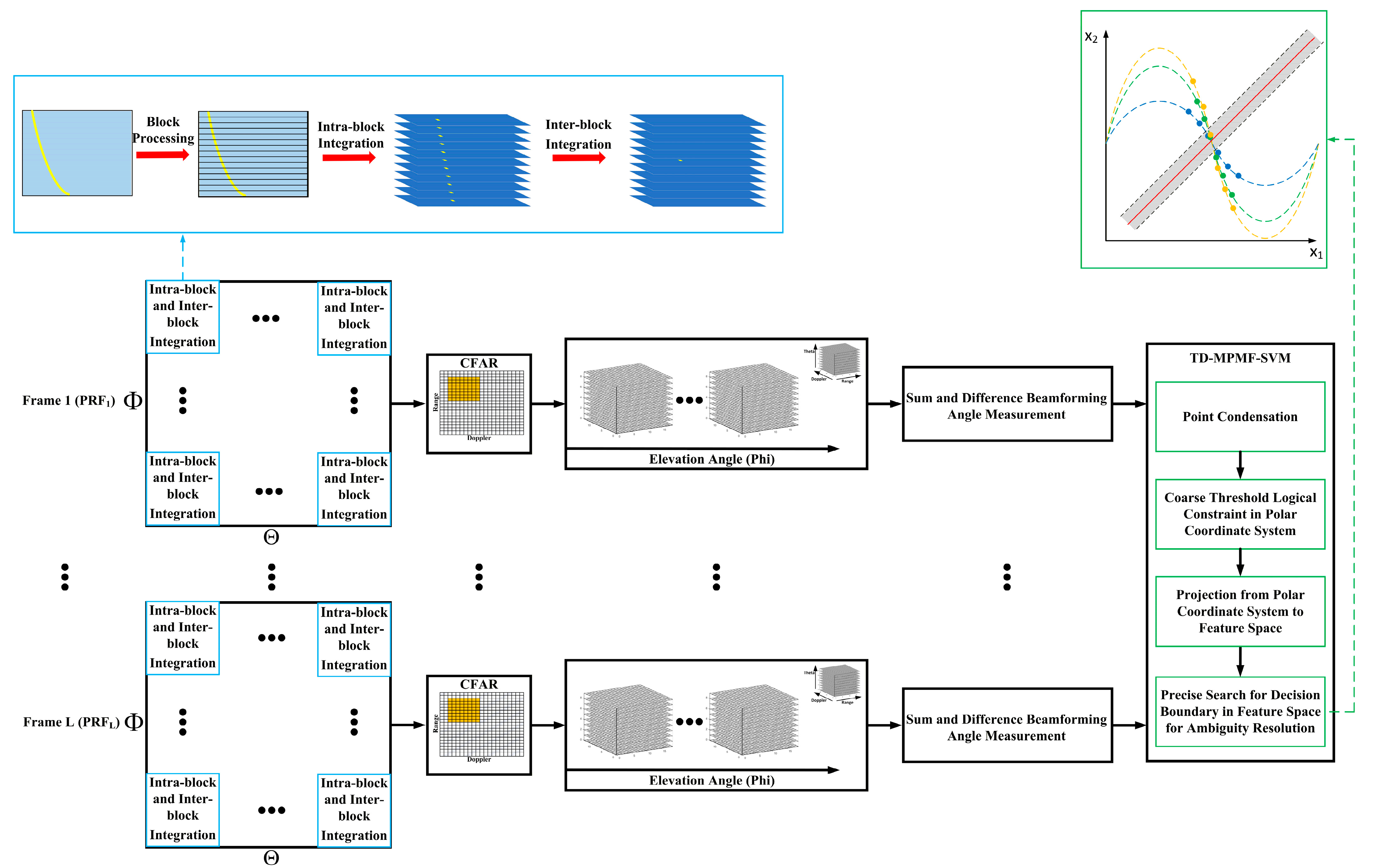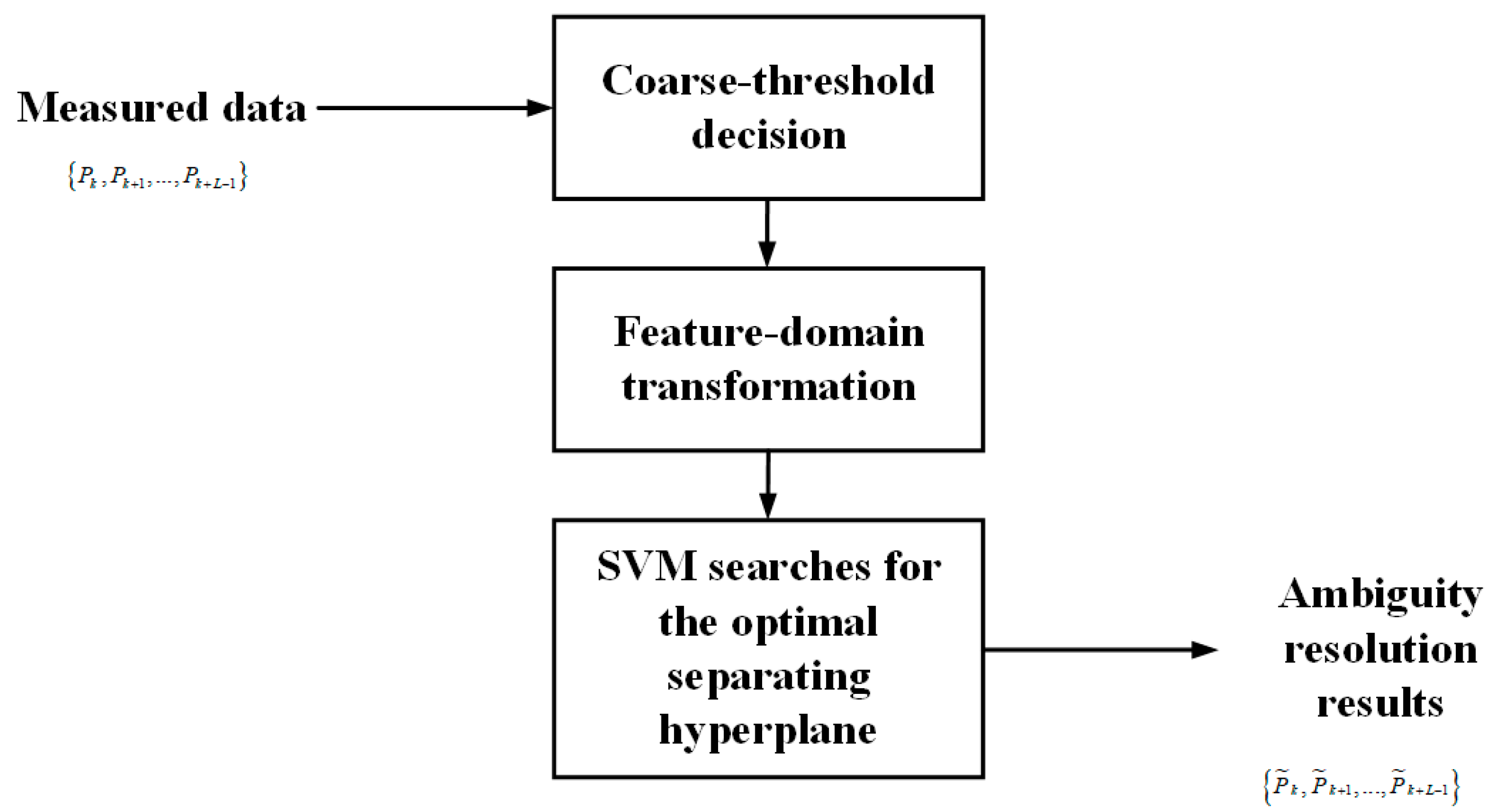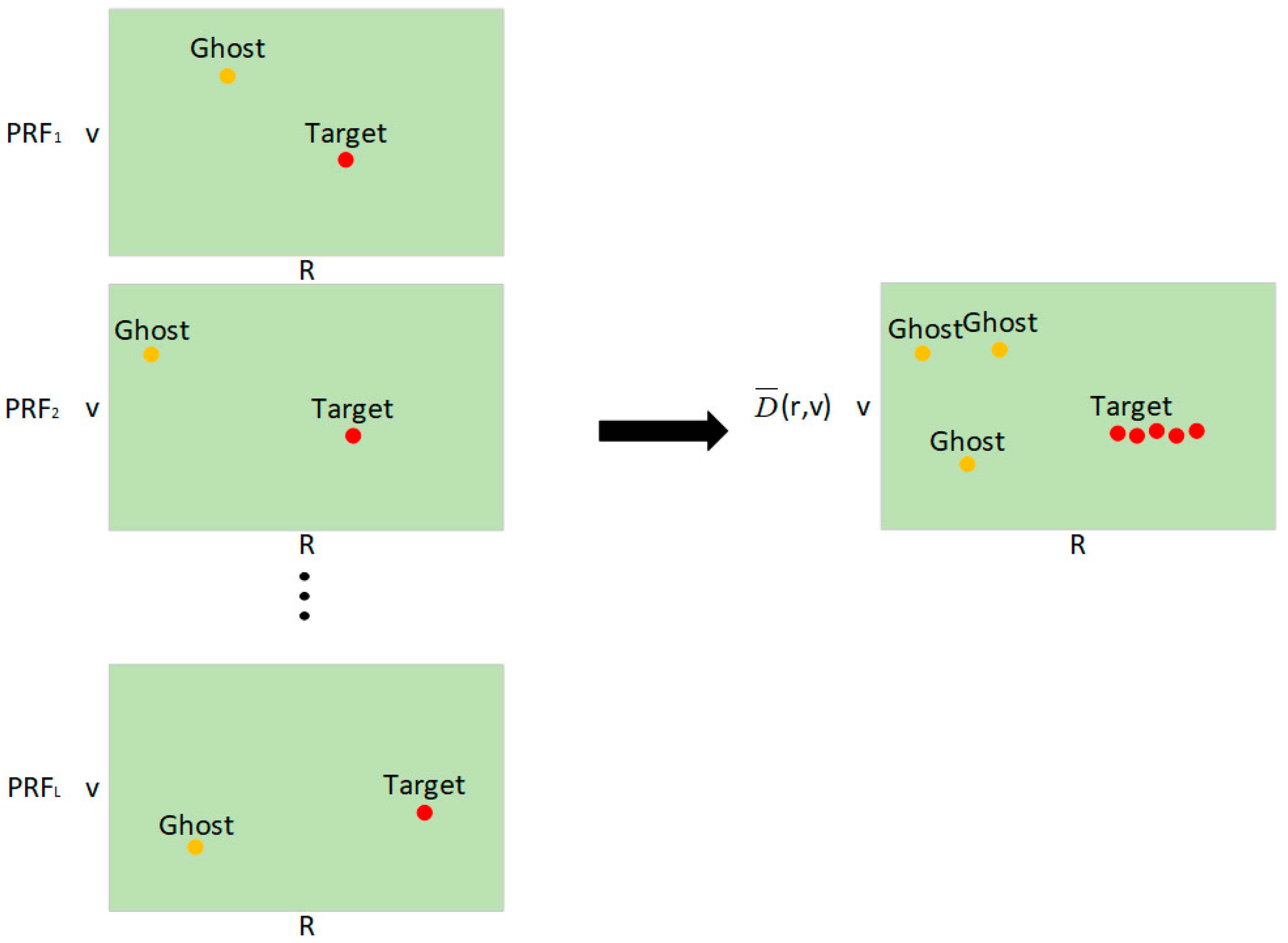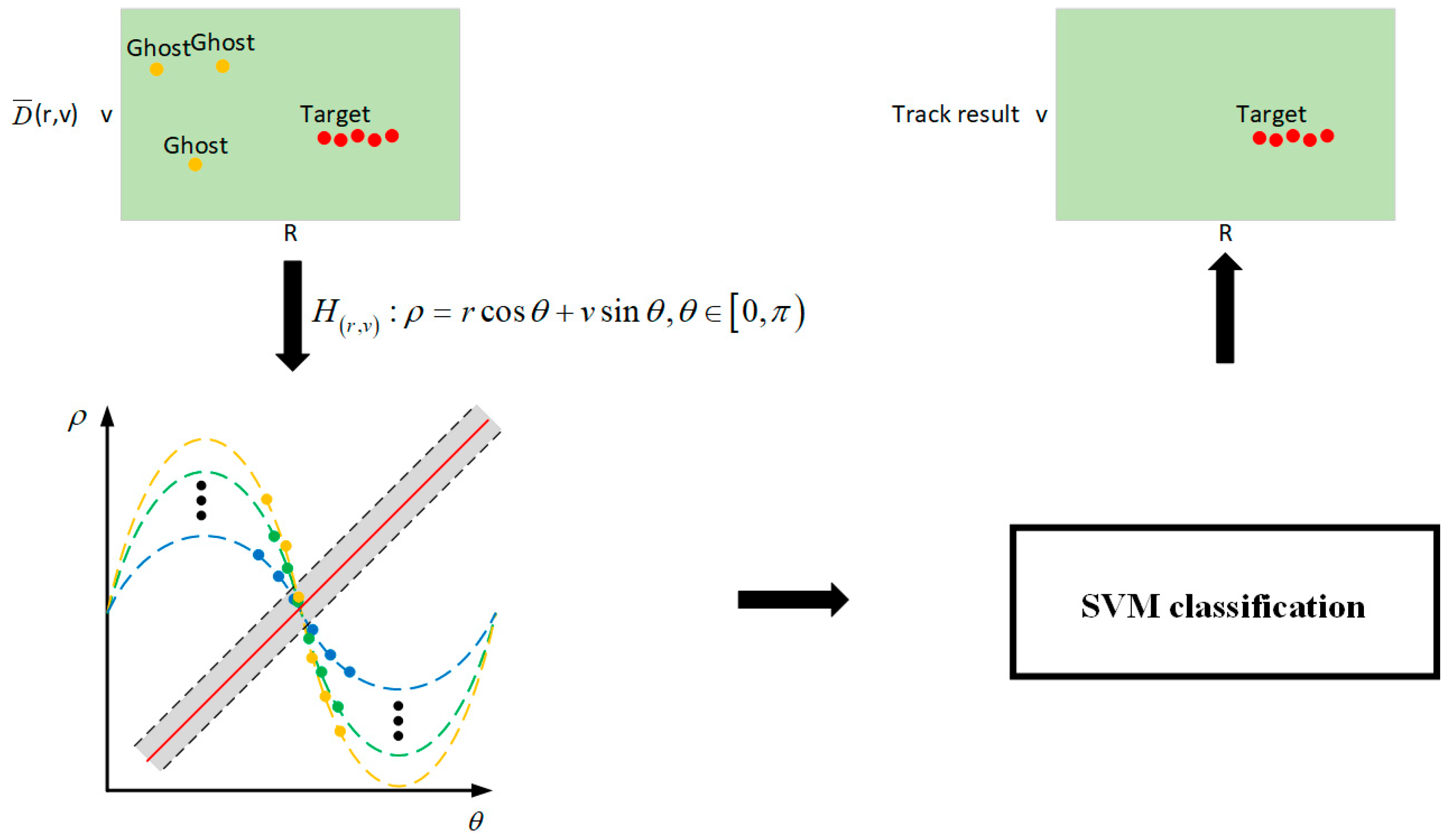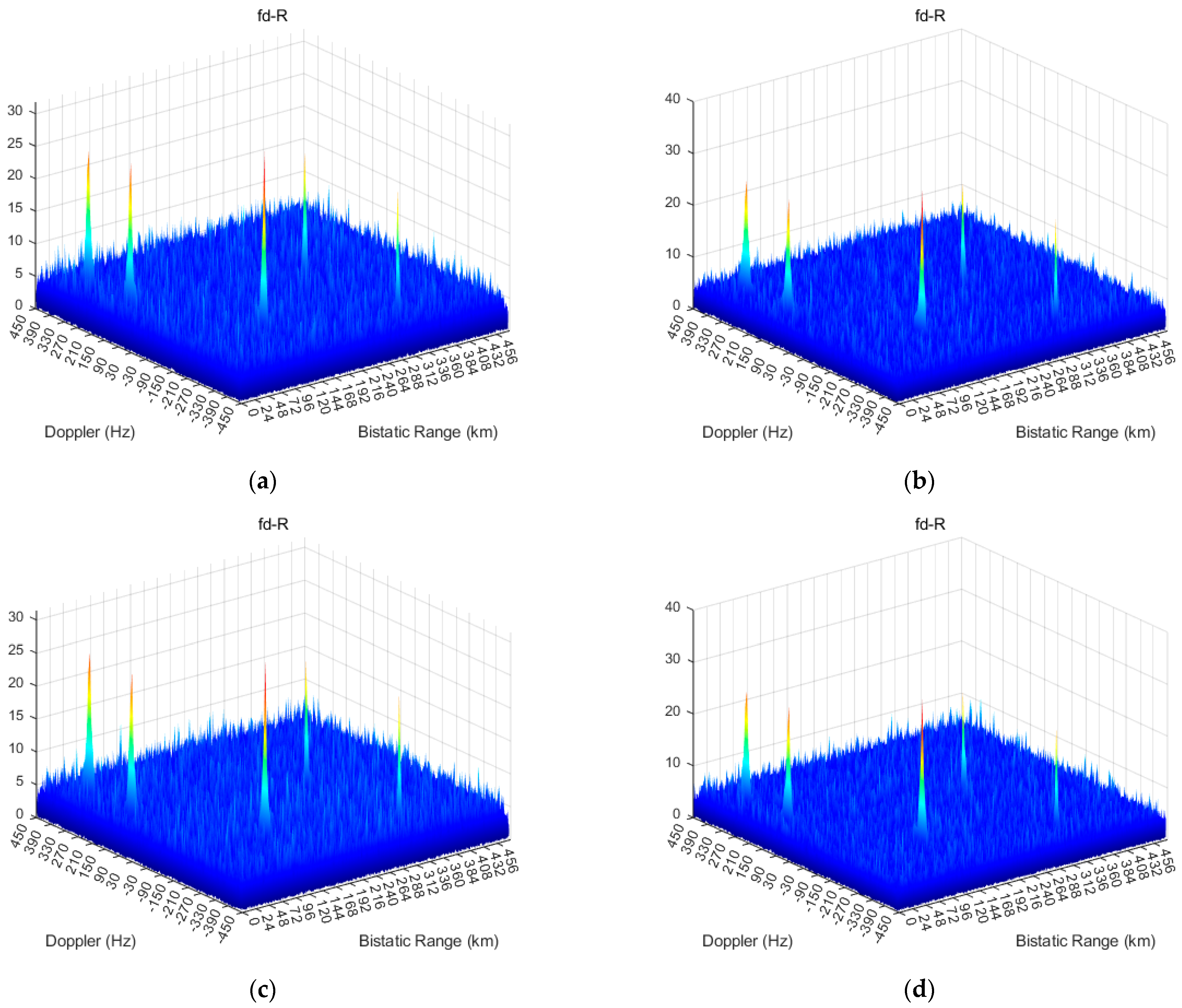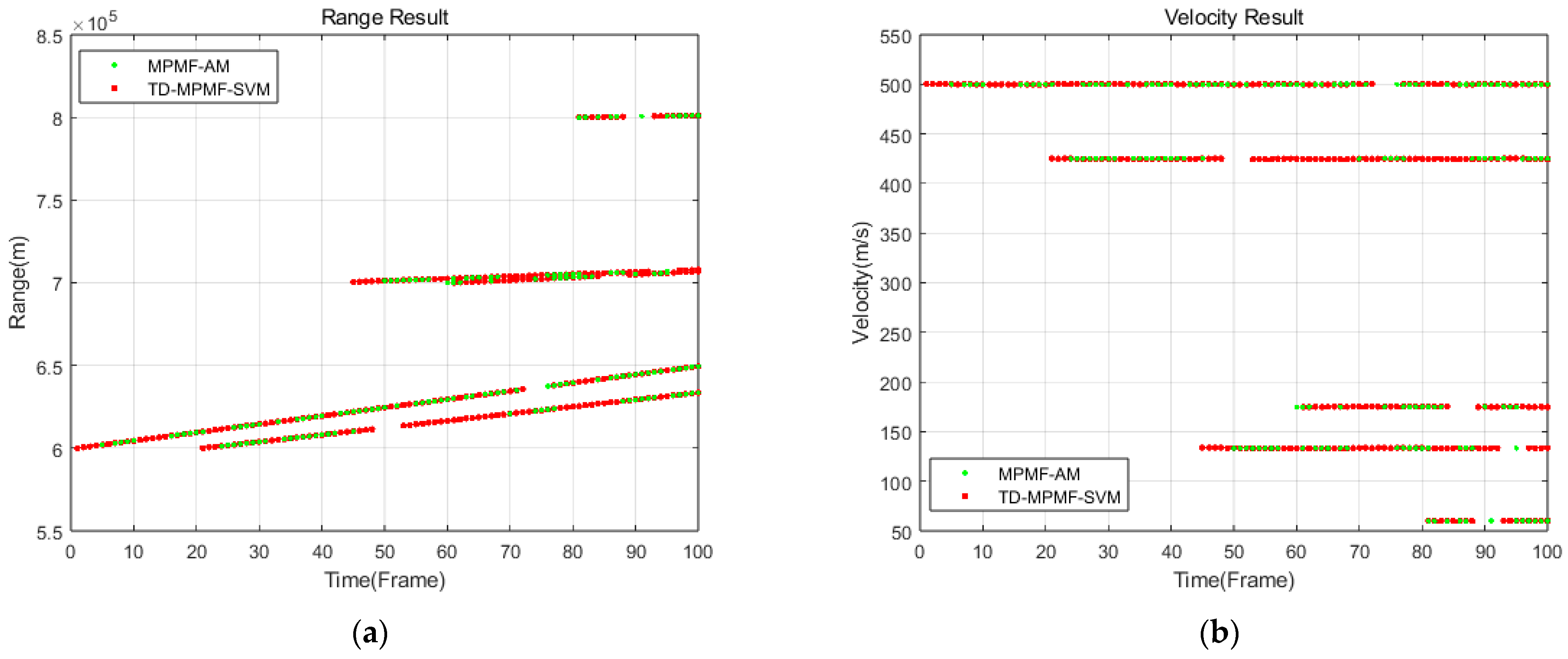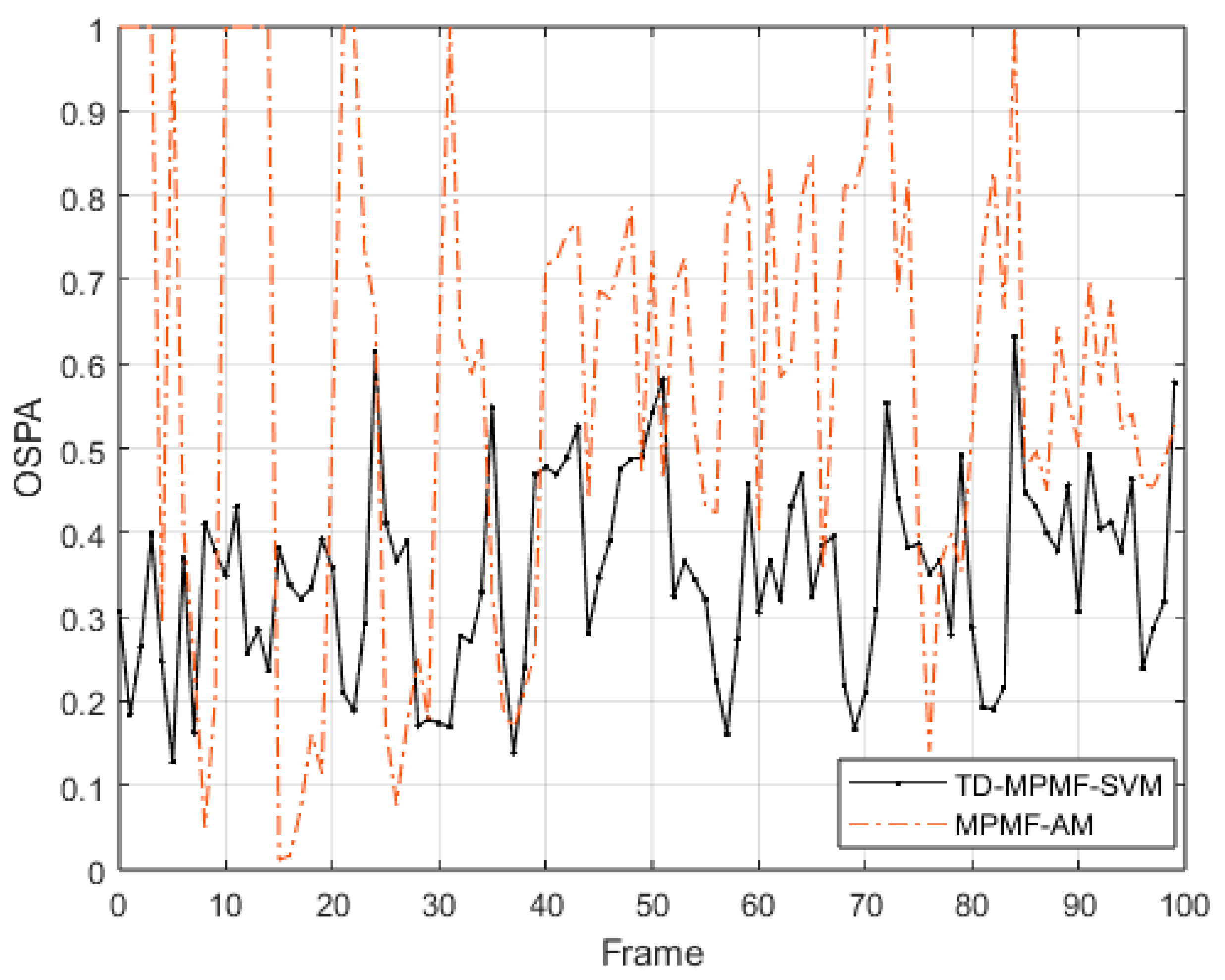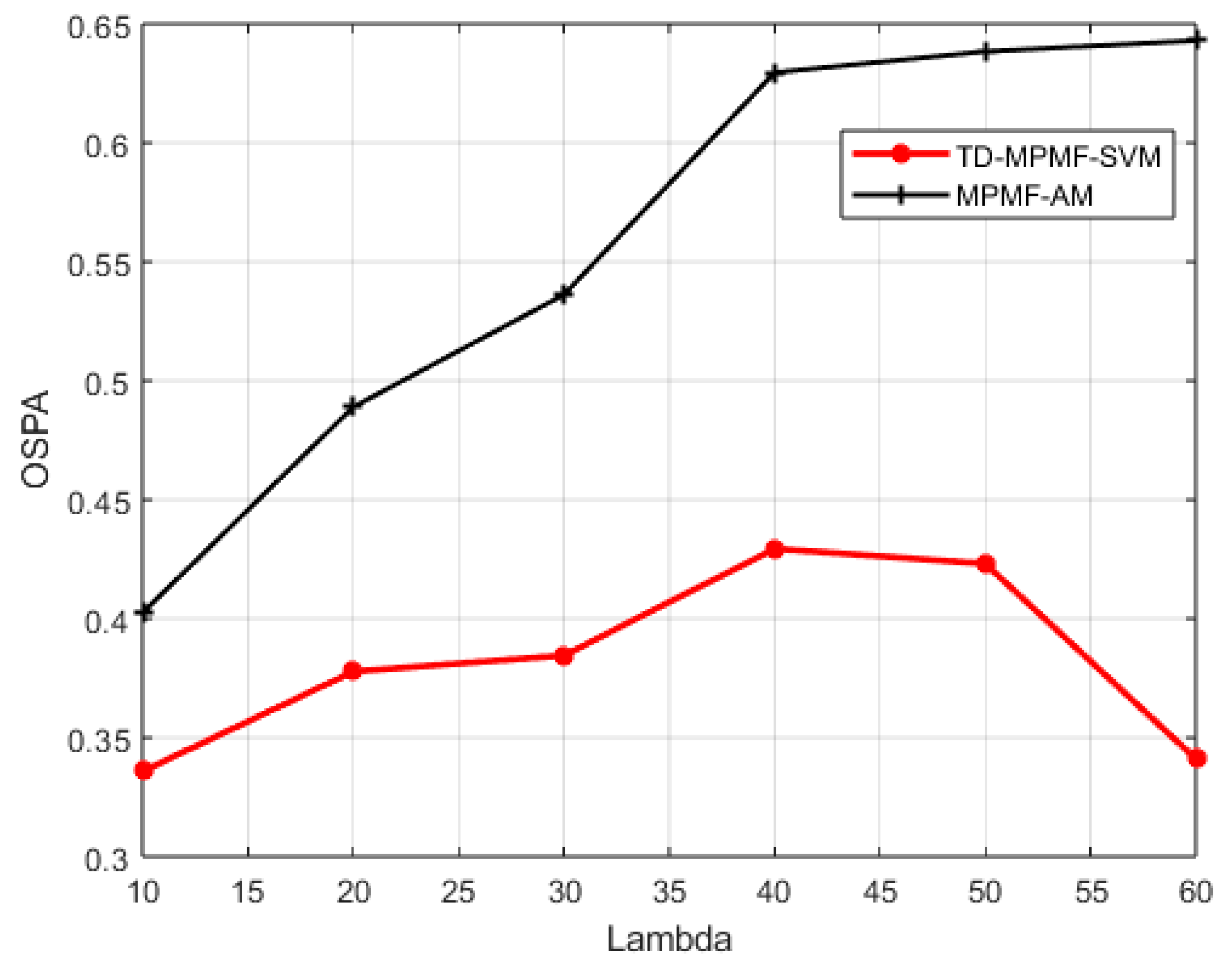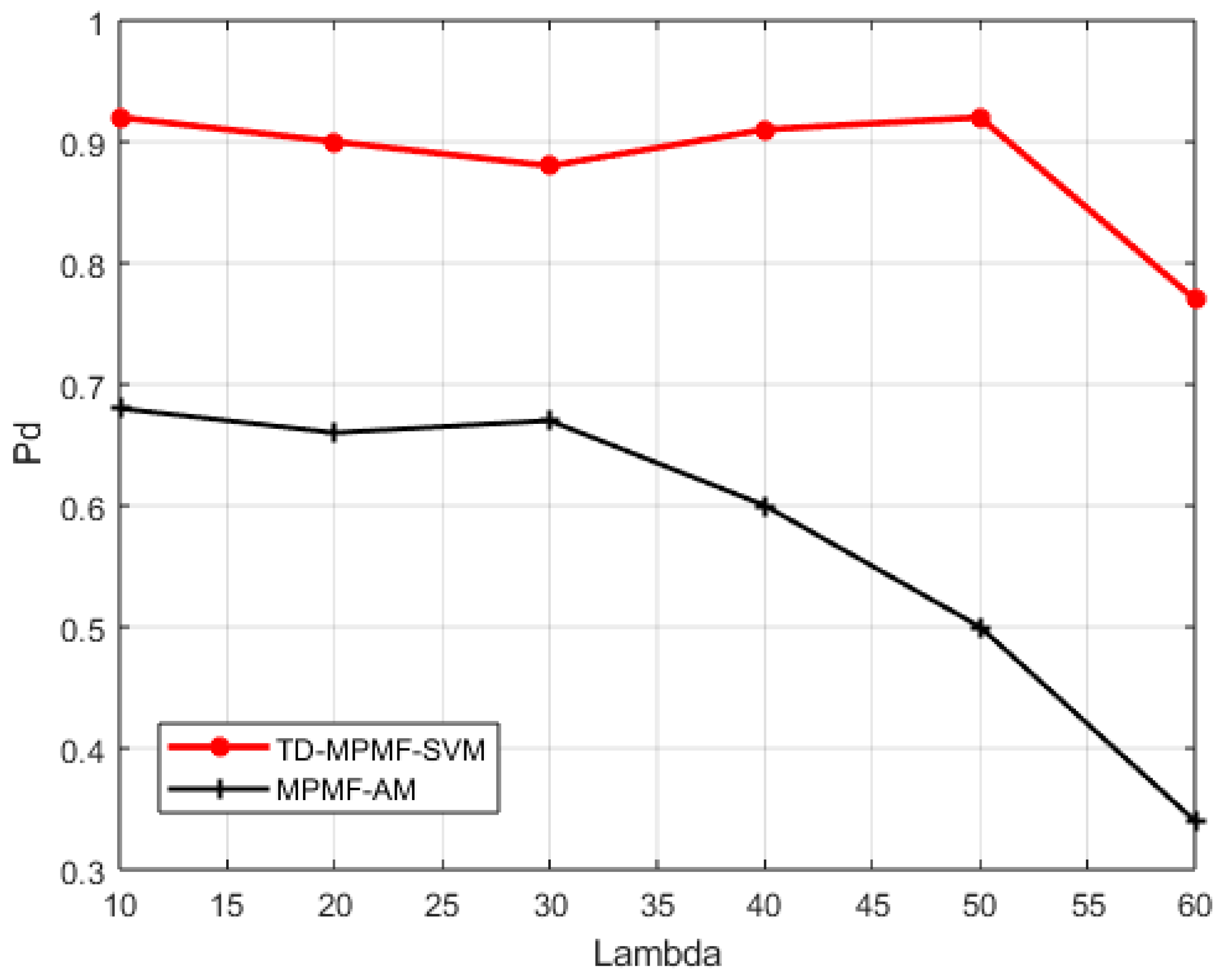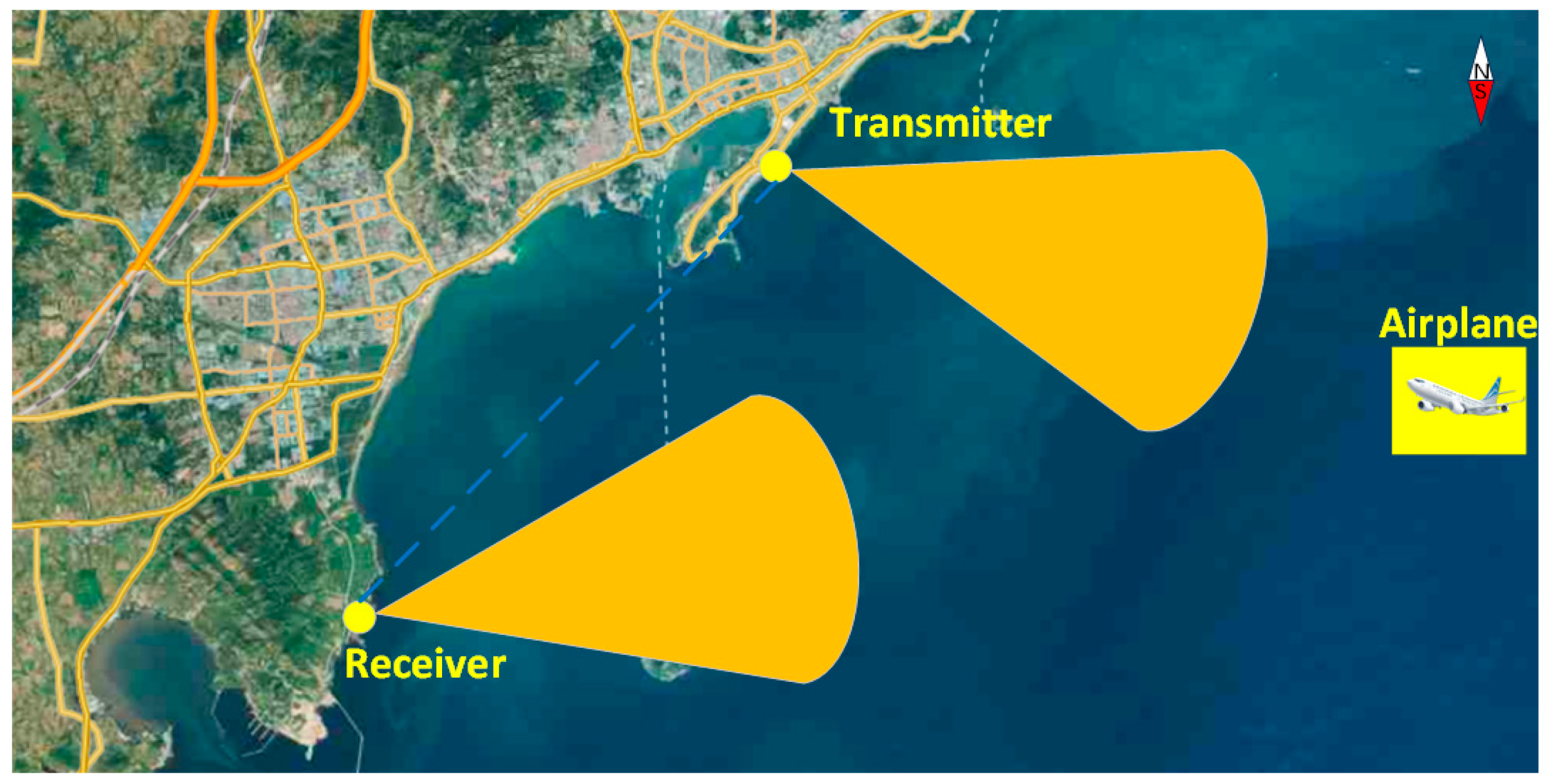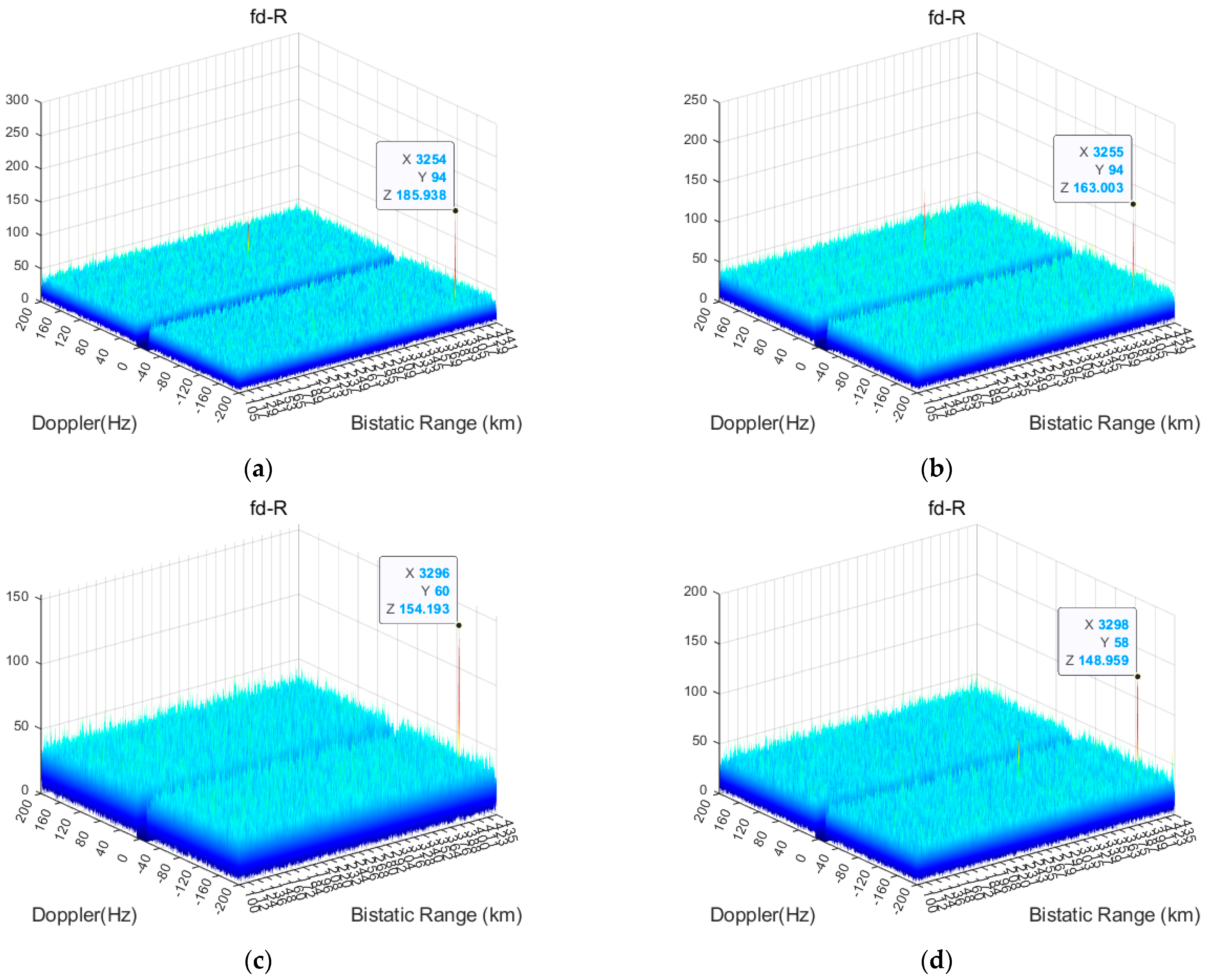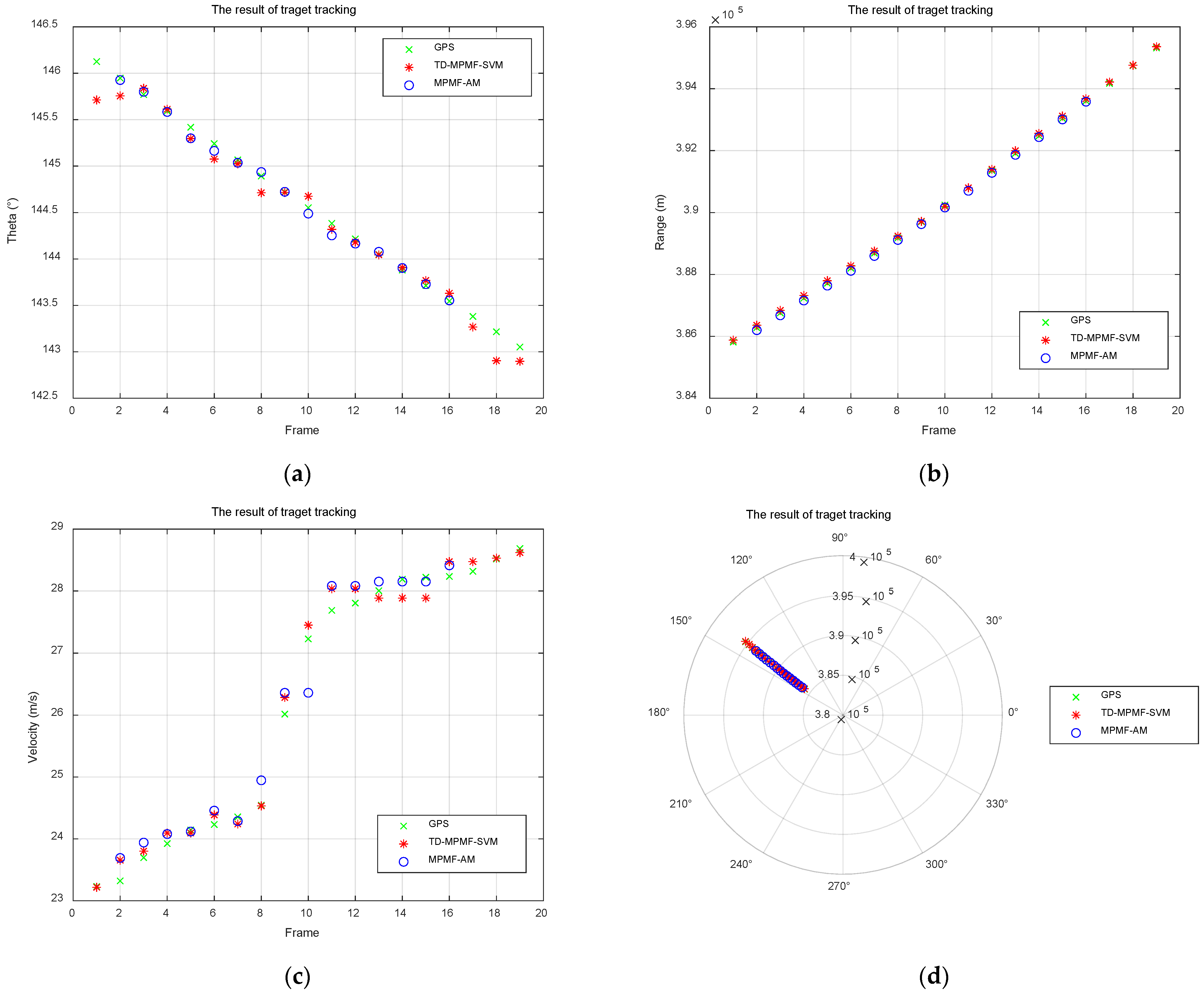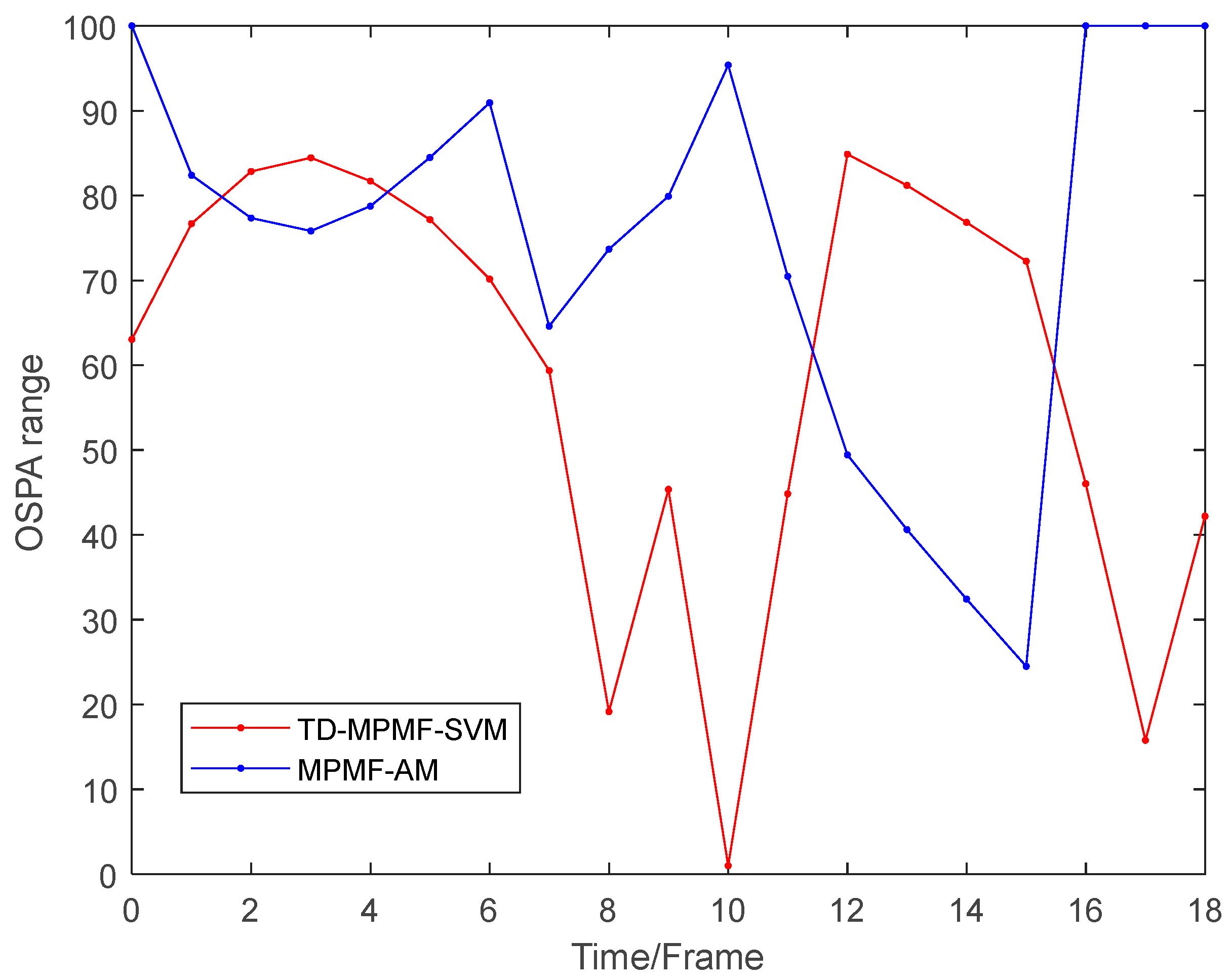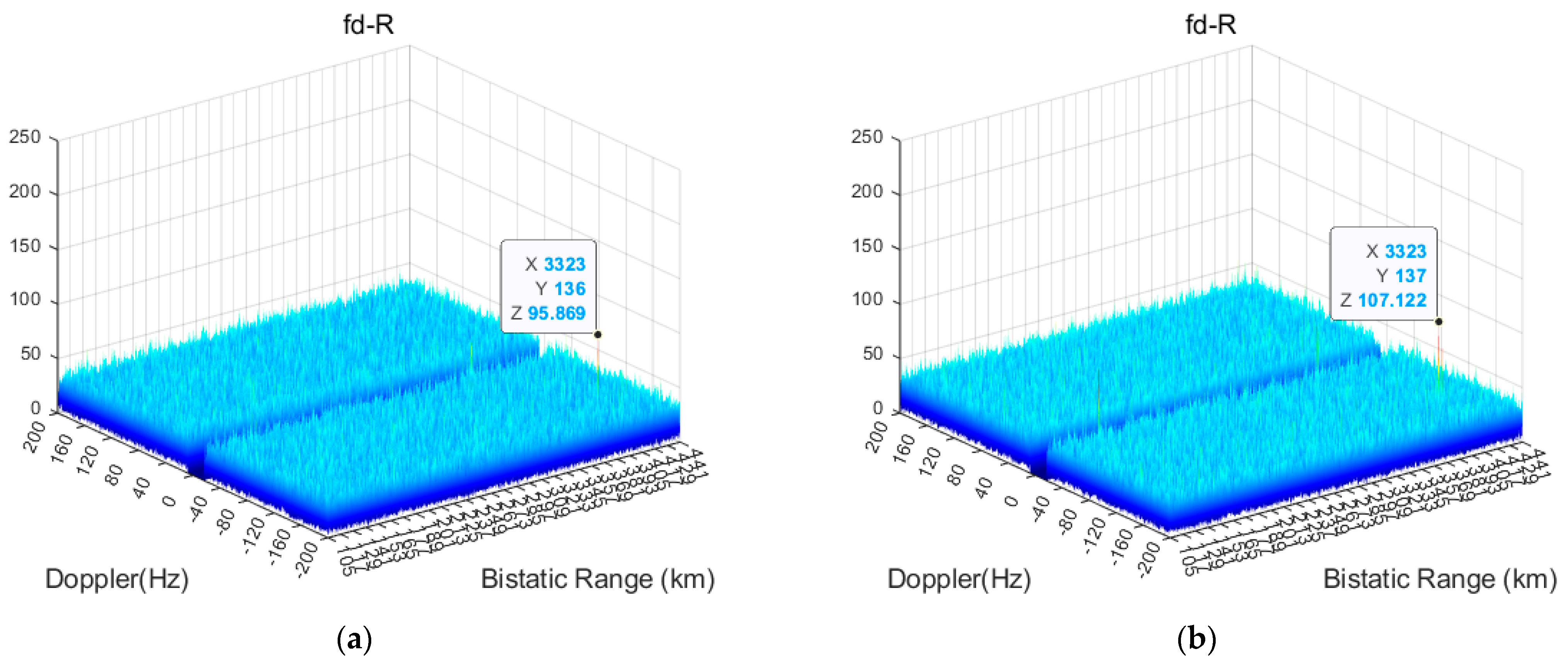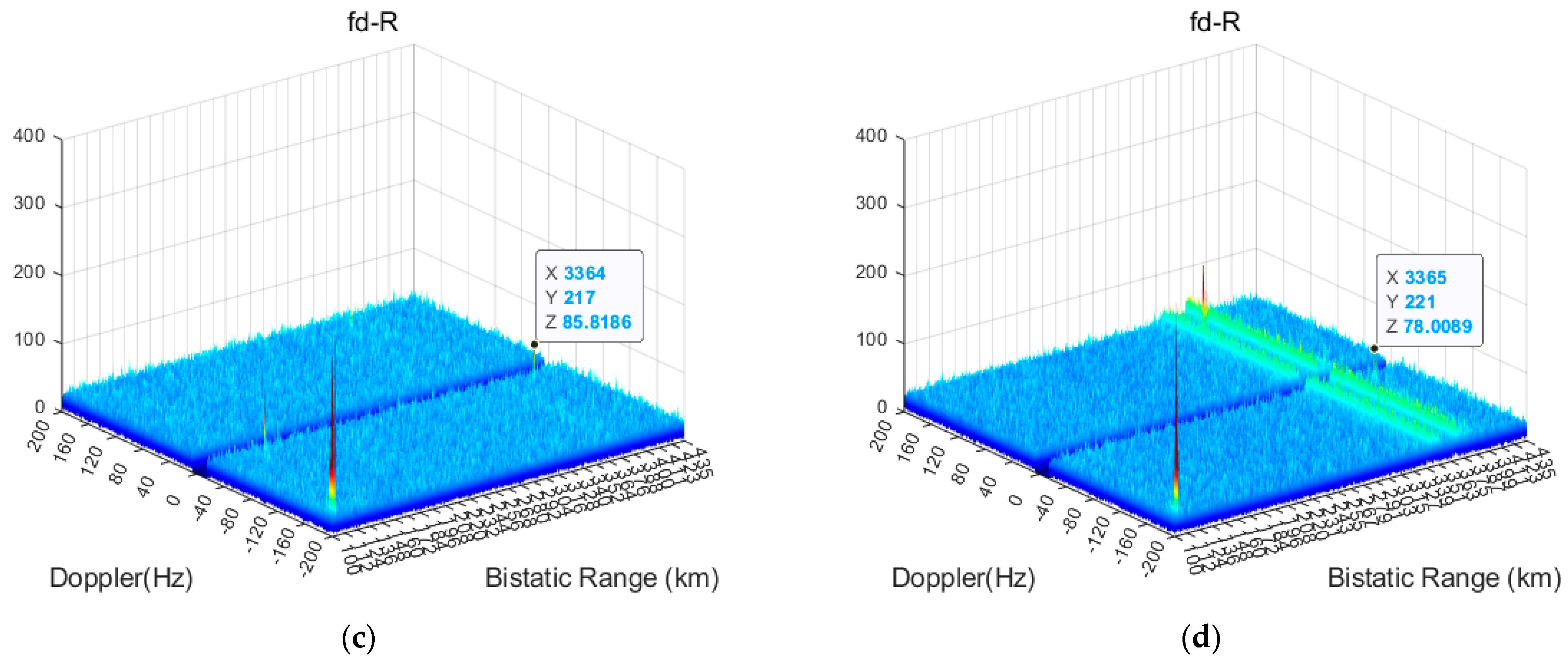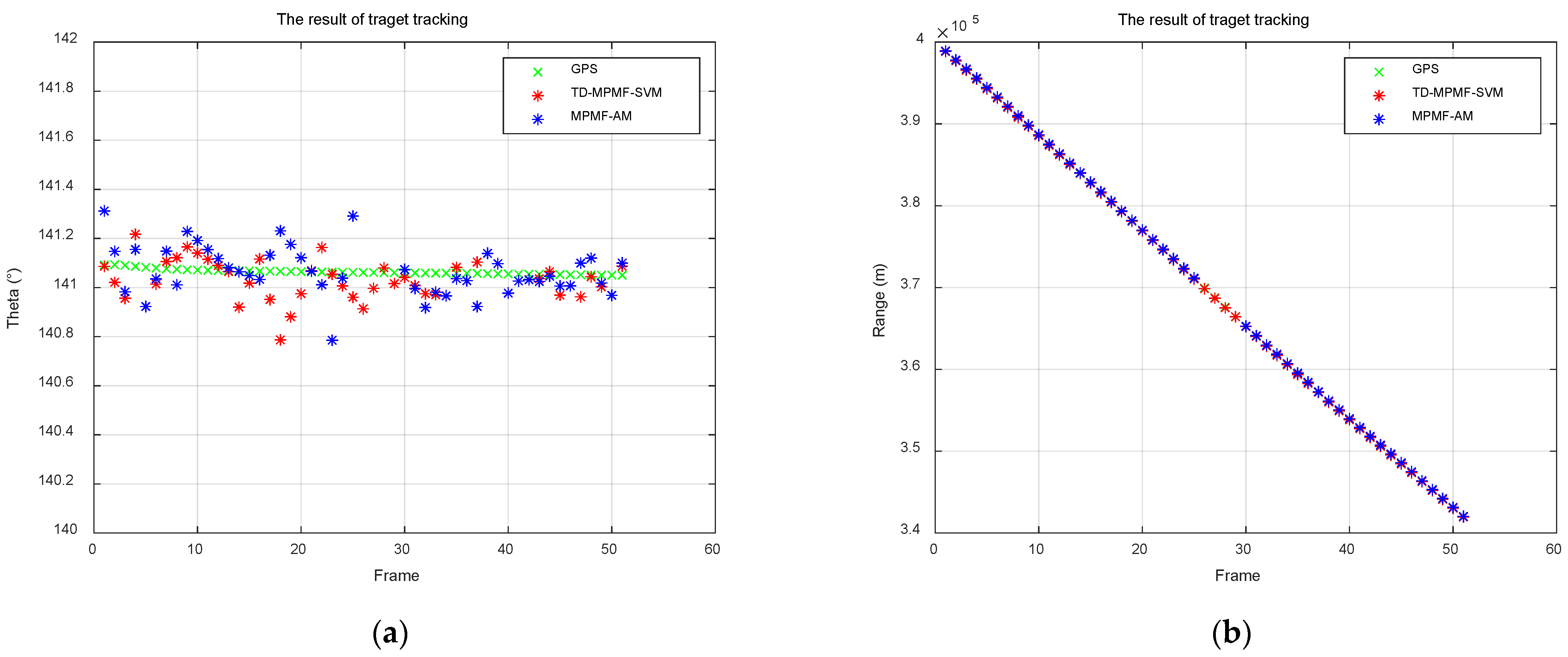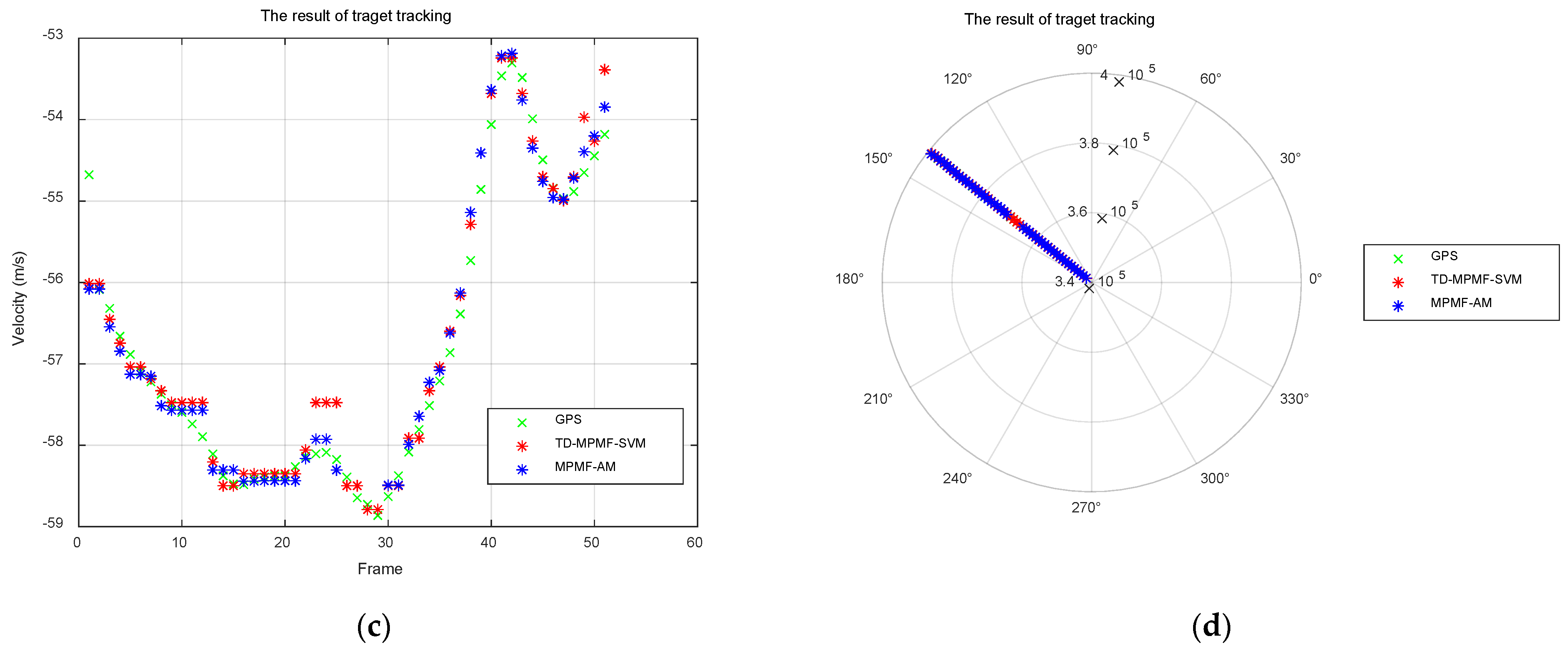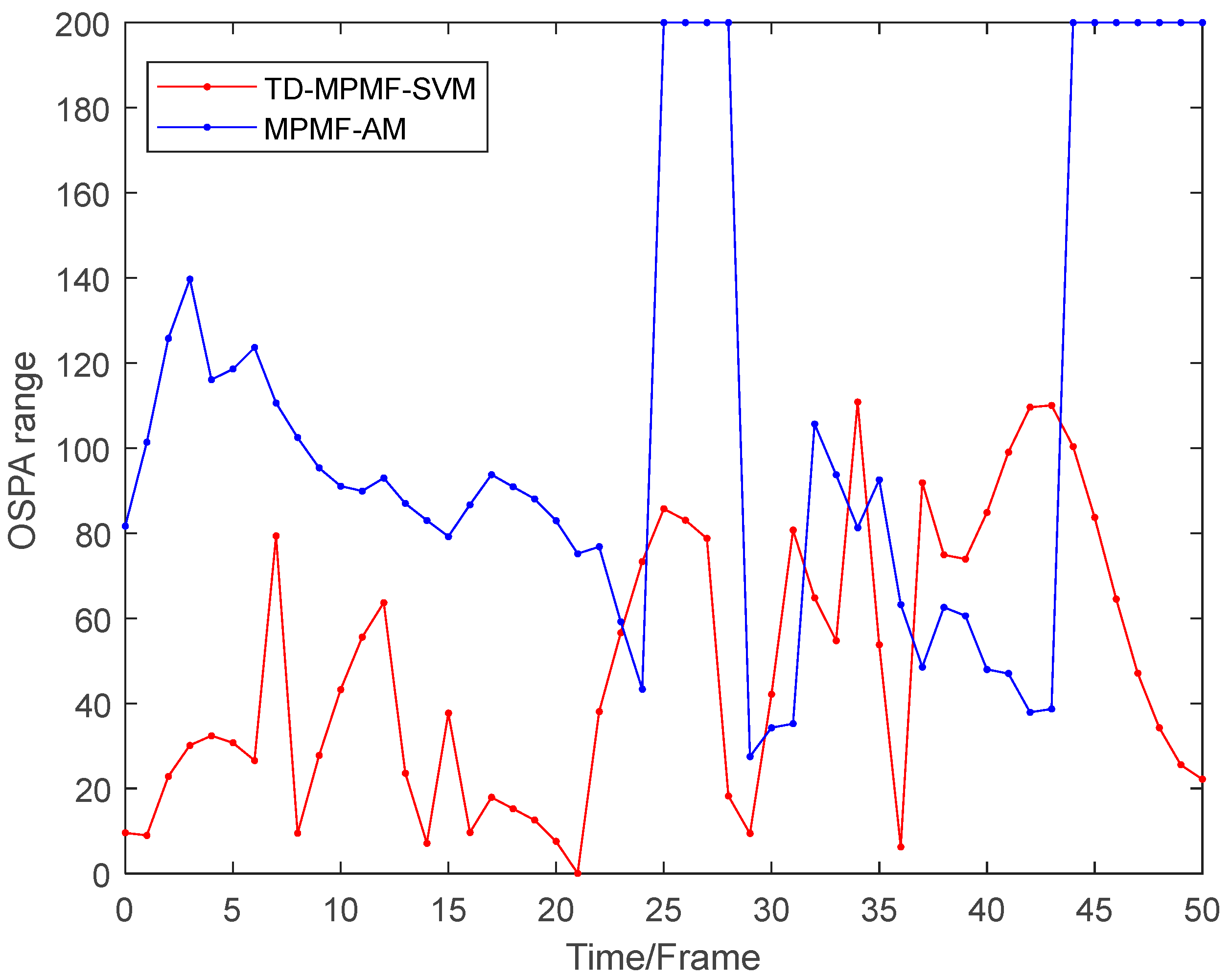4.1. Simulation Results
The detection performance of the TD-MPMF-SVM algorithm is compared with that of the MPMF-AM algorithm outlined in [
13]. The performance metrics used in the algorithm performance comparison are described as follows:
- 1.
Optimal sub-pattern assignment (OSPA) distance;
In mathematics, the OSPA distance is used to evaluate the difference between two finite sets in terms of both the number of elements and the individual differences [
30,
31]. Let
, where
is the cutoff distance,
is the target true state vector, while
is the estimated target state vector. For
, the OSPA distance is calculated as follows:
If , . is the distance order. In this paper, we set and .
- 2.
Target detection probability.
This represents the probability that the estimated state value of the target deviates from the true value within three grid cells.
The simulation scenario is as shown in
Figure 1. The number of PRFs in the multiple PRF radar system is set to
, and the relevant radar system parameters are shown in
Table 2. Since the coherent integration time for all PRFs is 1 s, the corresponding pulse numbers are 900, 1200, 1500, and 2100. In the simulation, the PRF values are set with a wide range, covering low, medium, and high PRF modes. The purpose of this setup is to verify that the TD-MPMF-SVM algorithm is applicable to all PRF modes.
Establish an East-North-Up (ENU) coordinate system with the receiving platform as the origin, where the -axis points east, the -axis points north, and the -axis points upward (towards the sky). The smallest angle required to rotate clockwise or counterclockwise from the north direction around the -axis to the projection of the target point on the plane is denoted as . A clockwise rotation is considered positive, and the azimuth angle ranges from −180° to 180°. is defined as the angle between the line connecting the origin and the target point and the plane. The elevation angle is positive when the target is above the plane and negative when it is below the plane, with a range from −90° to 90°. The receiving platform is an aircraft platform, flying in the stratosphere at an altitude of 11,000 m. The initial coordinates of the high-orbit satellite are . The velocity of the high-orbit satellite is 3000 m/s.
To more effectively demonstrate the performance of the algorithm, a time-varying scenario is designed. The total number of simulation frames is 100, with a maximum of five targets, all with CV linear motion. The appearance times of the five targets are 0 s, 20 s, 40 s, 60 s, and 80 s, respectively. Their initial distance, radial velocity, azimuth angle, and elevation angle are as follows: .
Coherent integration results in the Doppler/range domain for four consecutive frames are presented. All coherent integration results were obtained in the presence of range and Doppler ambiguities. At k = 80, 81, 82, 83, the coherent integration results of the target are shown in
Figure 8. The figure shows the coherent integration results for five targets under different PRFs. It can be observed that, under TD PRF mode, the same targets generate relative range.
The CFAR parameters are shown in
Table 3. We performed CFAR detection on the results of the secondary coherent processing to obtain the target measurements as shown in
Table 4 and
Table 5.
To verify the algorithm’s effectiveness in suppressing ghosts, ghosts are generated at each time step using a random process. The generation process of ghosts follows a Poisson distribution with an intensity of
, and their spatial distribution follows a uniform distribution. When
, the ambiguity resolution results of the two algorithms are shown in
Figure 9, and the OSPA distance results are shown in
Figure 10.
Figure 9 compares the frame-by-frame range and velocity estimates for five targets obtained by the baseline MPMF-AM and the proposed TD-MPMF-SVM algorithm.
Figure 9 shows that the MPMF-AM algorithm produces more frequent track fragmentation, while the proposed TD-MPMF-SVM method more accurately and continuously recovers the targets’ true bistatic ranges and radial velocities. Across the full sequence of
Figure 10, TD-MPMF-SVM yields systematically lower OSPA values than MPMF-AM, indicating that the proposed method attains smaller combined errors in target localization and target number estimation. The proposed TD-MPMF-SVM algorithm significantly reduces OSPA errors relative to MPMF-AM, indicating improved ambiguity resolution and more continuous target tracking under TD-MPMF mode.
To demonstrate the detection performance of the algorithm under different clutter intensities, a single target
is simulated. The intensity of the Poisson random process is set to
, and each
is tested with 100 Monte Carlo trials. The average OSPA distances of the two algorithms are shown in
Figure 11. The results clearly demonstrate that the proposed TD-MPMF-SVM algorithm achieves better tracking performance than the MPMF-AM algorithm under different clutter intensities.
Figure 12 shows the detection probabilities of the two algorithms under different clutter intensities. In various clutter environments, TD-MPMF-SVM maintains a high detection probability and consistently outperforms the MPMF-AM algorithm. When the Poisson intensity
is less than 60, the detection probability of the TD-MPMF-SVM algorithm remains around 0.9.
4.2. Experimental Results
On 22 September 2024, an aircraft detection experiment was conducted in Qingdao, Shandong, China. The experimental scenario is shown in
Figure 13, and the radar system parameters are listed in
Table 6. Both the transmitter and receiver were ground-based platforms and located on the same side of the target. The ground-based receiving platform was oriented toward the target while simultaneously receiving the direct wave signal from the ground-based transmitting platform. The receiving array antenna employed digital beam forming (DBF) technology [
32] to achieve multi-channel signal reception.
The number of PRFs of the radar system is . Each PRF has a duty ratio of 0.1, and the corresponding azimuth integration time is 0.75 s. Each PRF constitutes a sub-frame. Four PRFs together form a large frame, with an interval of 10 s between consecutive large frames.
- 1.
Scenario 1
The aircraft maintains approximately CV radial motion while performing cross-beam movement, causing continuous changes in its angle. In frames 13, 14, 15, and 16, the target coherent integration results are shown in
Figure 14 and the SNR from CFAR detection is listed in
Table 7.
The CFAR detection results are processed using sum-difference beamforming angle estimation to obtain the azimuth angle. The target angle results are shown in
Figure 15a. Then, ambiguity resolution is performed to obtain the true distance and true velocity of the target. The true distance results are shown in
Figure 15b, while the true velocity results are in
Figure 15c. Finally, the Kalman filtering algorithm is applied for target tracking, and the results are shown in
Figure 15d.
To quantitatively compare the ambiguity resolution and tracking performance of TD-MPMF-SVM and MPMF-AM in MTD, we use OSPA as the evaluation metric, where
is 100 m. The results are shown in
Figure 16. The mean OSPA for TD-MPMF-SVM is 59.2 m, whereas that for MPMF-AM is 74.77 m. Based on these OSPA results, TD-MPMF-SVM demonstrates superior performance in moving target detection and tracking.
The root mean square error (RMSE) of the range and velocity ambiguity resolution results compared to the true values is shown in
Table 8.
- 2.
Scenario 2
The aircraft moves in a CV radial motion, with the direction of movement pointing towards the receiving platform. In frames 13, 14, 15, and 16, the target coherent integration results are shown in
Figure 17, and the CFAR detection SNR is presented in
Table 9.
The CFAR detection results are processed using sum-difference beamforming angle estimation to obtain the azimuth angle. The target angle results are shown in
Figure 18a. Then, ambiguity resolution is performed to obtain the true distance and true velocity of the target. The true distance results are shown in
Figure 18b, and the true velocity results are in
Figure 18c. Finally, the Kalman filtering results are shown in
Figure 18d.
To quantitatively compare the ambiguity resolution and tracking performance of TD-MPMF-SVM and MPMF-AM in MTD, we use OSPA as the evaluation metric, where
is 200 m. The results are shown in
Figure 19. The mean OSPA for TD-MPMF-SVM is 48.05 m, whereas that for MPMF-AM is 106.12 m. Based on these OSPA results, TD-MPMF-SVM demonstrates superior performance in moving target detection and tracking.
The results for the range and velocity ambiguity resolution results compared to the true values are shown in
Table 10.
